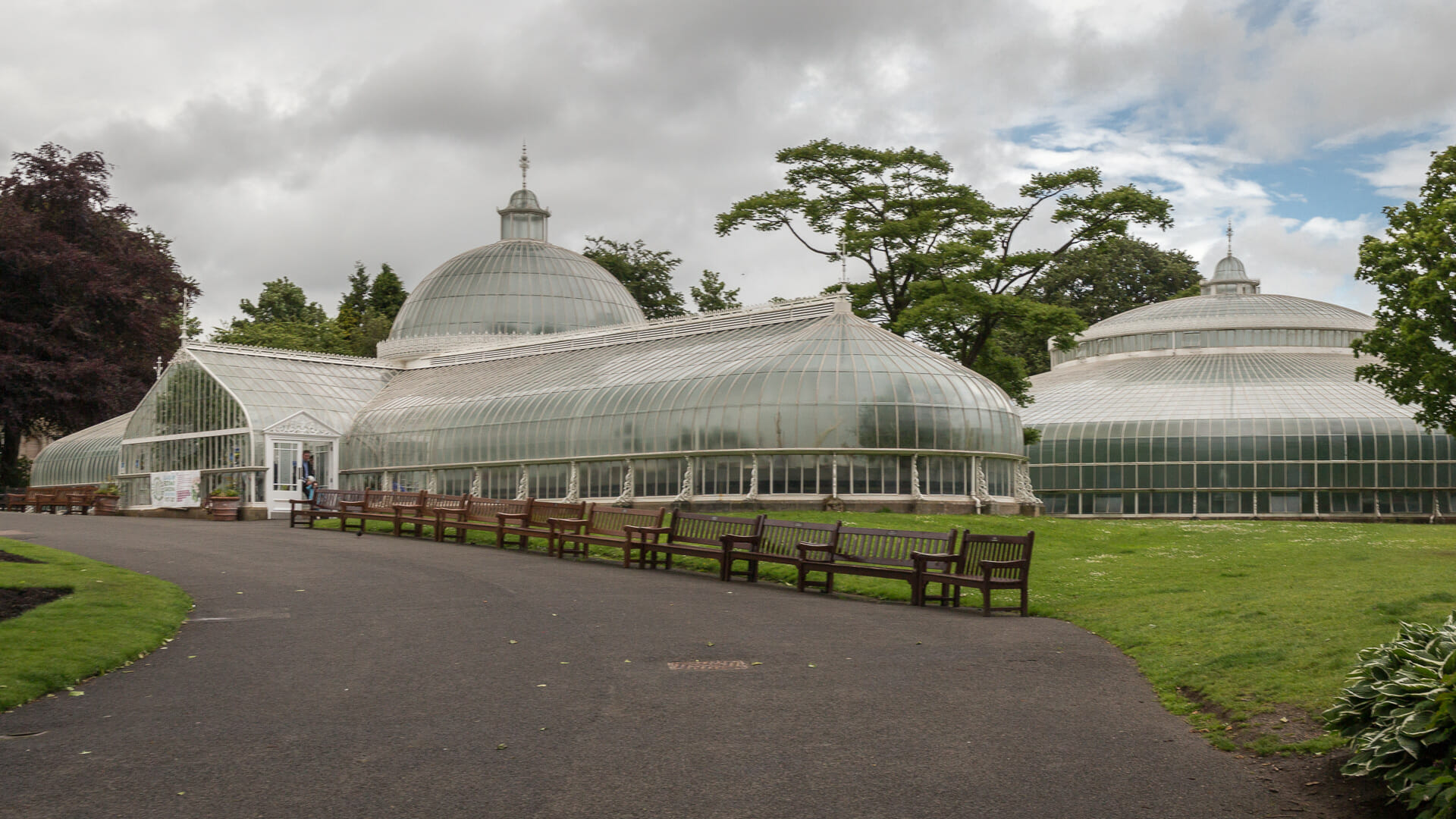A dream in glass – the Victorian halls of Glasgow Botanic Gardens are a paradise for visitors and plants alike.

Just one step off Glasgow’s busy arterial road, the Great Western Road, through a large gate and the visitor enters a Victorian oasis of calm, where old buildings and beautiful plants are on show: the Glasgow Botanic Gardens.
Paths wind between green areas, trees stretch up to the sky on the horizon and in between, nimble grey squirrels dart between the park benches.
Glasgow Botanic Gardens celebrated its bicentenary in 2017, but the impressive Glasgow is somewhat younger. The “Kibble Palace” was only erected here in 1873 – it previously belonged to the wealthy eccentric John Kibble, who had it built on Loch Long to the west of Glasgow.
As is so often the case with museums and public buildings in Glasgow, admission to the gardens is free. The idea is that visitors can take a break from the hustle and bustle of the city and get to know the many thousands of plants in peace and quiet.
Naturally, the Glass Palace beckons visitors to enter. It was not always intended as a greenhouse. Meetings were once held here and concerts performed. But from 1880 onwards, the managers of the gardens grew tree ferns in the round building at the back.
Today, the oldest of these are over 120 years old. They stretch up to the glass roof between the pillars, which are adorned with cast-iron decorations, and are reflected in the facets of the reflectors. This marvellous sight opens up as you enter.
Incidentally, the naked lady on the plinth is Eve, who is probably looking around her paradise here. She and seven other sculptures are housed in Kibble Palace. They all date from the last half of the 19th century.
The front part of the greenhouse mainly houses cacti. Incidentally, there are also small concerts and other events in the Kibble Palace nowadays.
However, the greenhouse is not really that big. When visitors leave it again and walk a little further along the path, the large “Main Range” appears, which dates back to 1878.
And the danger of getting lost is much greater here: narrow paths lead through the beds, which are all at about waist height and produce a splendour of flowers and plants. Doors open in all directions.
Marvellous blossoms always catch the eye.
In some habitats there are also ponds where fish live.
The large Main Range and the Kibble Palace also make Glasgow Botanic Garden a suitable destination for a day out in the rain – which is not so rare in Glasgow. However, if it does stay dry, the outdoor area is of course also interesting. Here, for example, you can admire the rose garden in summer. Incidentally, a plaque with a rose in the style of the artist Charles Rennie Mackintosh is embedded in the floor of the park, reminding us that Glasgow was the City of Roses in 2003.
There are also herb gardens and edible plants on display. However, visitors are advised not to eat them if they are feeling peckish. Instead, the park’s café offers scones and tea.
The Glasgow Botanic Gardens are definitely worth a visit for the beautiful Kibble Palace and the large collection of plants.
Knowledge: About the Glasgow Botanic Gardens
in 2017, the botanic gardens celebrated their bicentenary. But they have not been in this location for that long. They were originally located in Sandyford, near the Kelvingrove Museum – which was on the outskirts of the city back then. And it wasn’t to make life more beautiful for Glaswegians, but to supply the nearby university with plants for teaching.
After just eight years, the curator at the time had collected 12,000 species. An enormous achievement, which soon led to the need to find a new and larger location. in 1842, the botanical garden finally opened in its current location on the banks of the River Kelvin.
In 1873, Kibble Palace moved into its new home in the gardens. In 2003, however, the proud glasshouse was in such a poor state that it had to be completely dismantled and renovated at a cost of seven million pounds. After three years, the refurbished building was back on its feet, displaying its wonderful cast-iron ornaments in their former splendour.
Today, the gardens are run by Glasgow City Council, supported by The Friends of Glasgow Botanic Gardens.
How to get there:
With satnav: enter “G12 0UE” and then select the corner of Queen Margaret Dr and Great Western Road.
Without satnav: Whether you are coming from the city centre or from outside, you have to take the Great Western Road A82. The gardens are located directly on this road. You can park on the road, but there is no extra car park.
On foot/public transport: It is much easier to reach the gardens on foot or by public transport. For example, if you take the City Sightseeing Tours, you can get off at Byres Road and walk about 600 metres north to the Glasgow Botanic Gardens. You can also take the underground, which stops at Hillhead, and walk 500 metres north from here.
Alternatively, you can first visit the University of Glasgow and then walk about a quarter of an hour from there.